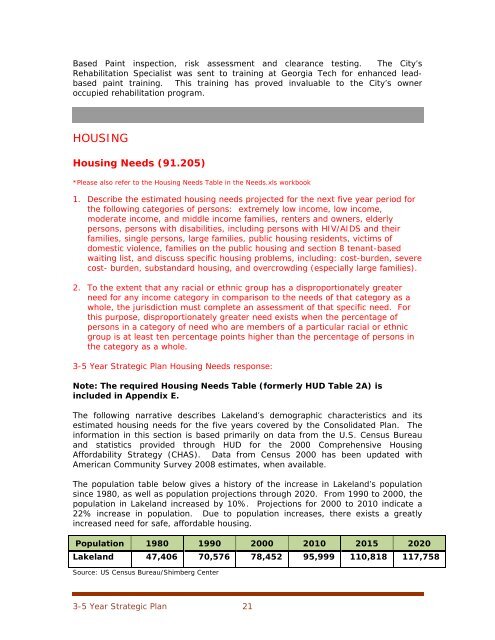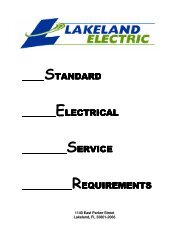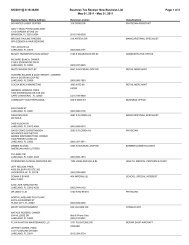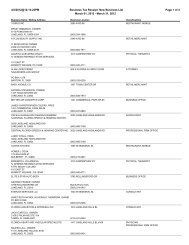CONSOLIDATED PLAN & STRATEGY 5-YEAR ... - City of Lakeland
CONSOLIDATED PLAN & STRATEGY 5-YEAR ... - City of Lakeland
CONSOLIDATED PLAN & STRATEGY 5-YEAR ... - City of Lakeland
Create successful ePaper yourself
Turn your PDF publications into a flip-book with our unique Google optimized e-Paper software.
Based Paint inspection, risk assessment and clearance testing. The <strong>City</strong>’s<br />
Rehabilitation Specialist was sent to training at Georgia Tech for enhanced leadbased<br />
paint training. This training has proved invaluable to the <strong>City</strong>’s owner<br />
occupied rehabilitation program.<br />
HOUSING<br />
Housing Needs (91.205)<br />
*Please also refer to the Housing Needs Table in the Needs.xls workbook<br />
1. Describe the estimated housing needs projected for the next five year period for<br />
the following categories <strong>of</strong> persons: extremely low income, low income,<br />
moderate income, and middle income families, renters and owners, elderly<br />
persons, persons with disabilities, including persons with HIV/AIDS and their<br />
families, single persons, large families, public housing residents, victims <strong>of</strong><br />
domestic violence, families on the public housing and section 8 tenant-based<br />
waiting list, and discuss specific housing problems, including: cost-burden, severe<br />
cost- burden, substandard housing, and overcrowding (especially large families).<br />
2. To the extent that any racial or ethnic group has a disproportionately greater<br />
need for any income category in comparison to the needs <strong>of</strong> that category as a<br />
whole, the jurisdiction must complete an assessment <strong>of</strong> that specific need. For<br />
this purpose, disproportionately greater need exists when the percentage <strong>of</strong><br />
persons in a category <strong>of</strong> need who are members <strong>of</strong> a particular racial or ethnic<br />
group is at least ten percentage points higher than the percentage <strong>of</strong> persons in<br />
the category as a whole.<br />
3-5 Year Strategic Plan Housing Needs response:<br />
Note: The required Housing Needs Table (formerly HUD Table 2A) is<br />
included in Appendix E.<br />
The following narrative describes <strong>Lakeland</strong>’s demographic characteristics and its<br />
estimated housing needs for the five years covered by the Consolidated Plan. The<br />
information in this section is based primarily on data from the U.S. Census Bureau<br />
and statistics provided through HUD for the 2000 Comprehensive Housing<br />
Affordability Strategy (CHAS). Data from Census 2000 has been updated with<br />
American Community Survey 2008 estimates, when available.<br />
The population table below gives a history <strong>of</strong> the increase in <strong>Lakeland</strong>’s population<br />
since 1980, as well as population projections through 2020. From 1990 to 2000, the<br />
population in <strong>Lakeland</strong> increased by 10%. Projections for 2000 to 2010 indicate a<br />
22% increase in population. Due to population increases, there exists a greatly<br />
increased need for safe, affordable housing.<br />
Population 1980 1990 2000 2010 2015 2020<br />
<strong>Lakeland</strong> 47,406 70,576 78,452 95,999 110,818 117,758<br />
Source: US Census Bureau/Shimberg Center<br />
3-5 Year Strategic Plan 21
















